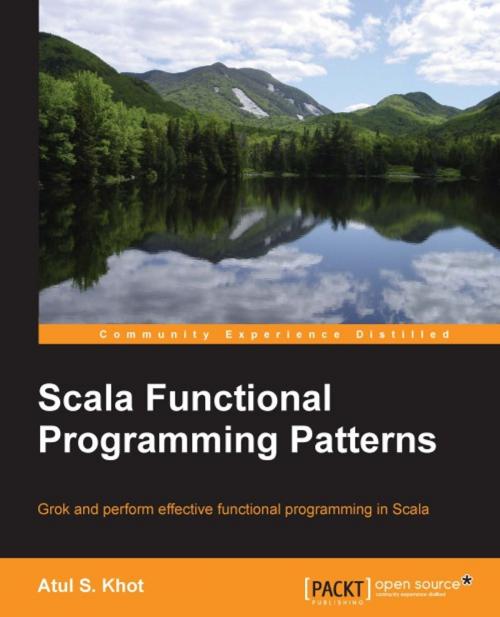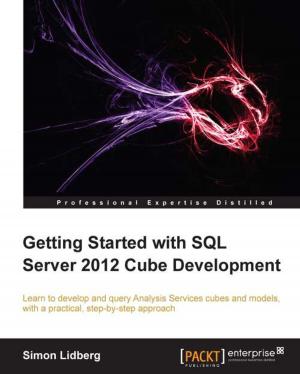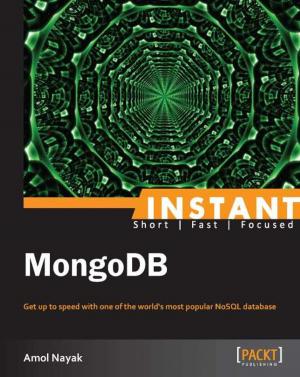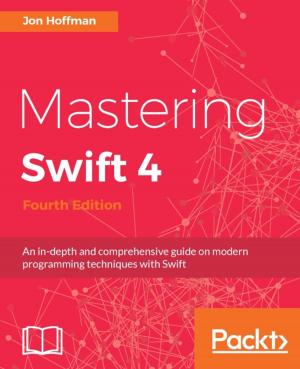Scala Functional Programming Patterns
Nonfiction, Computers, Programming, Object Oriented Programming, Programming Languages| Author: | Atul S. Khot | ISBN: | 9781783985852 |
| Publisher: | Packt Publishing | Publication: | September 19, 2016 |
| Imprint: | Packt Publishing | Language: | English |
| Author: | Atul S. Khot |
| ISBN: | 9781783985852 |
| Publisher: | Packt Publishing |
| Publication: | September 19, 2016 |
| Imprint: | Packt Publishing |
| Language: | English |
Grok and perform effective functional programming in Scala
About This Book
- Understand functional programming patterns by comparing them with the traditional object-oriented design patterns
- Write robust, safer, and better code using the declarative programming paradigm
- An illustrative guide for programmers to create functional programming patterns with Scala
Who This Book Is For
If you have done Java programming before and have a basic knowledge of Scala and its syntax, then this book is an ideal choice to help you to understand the context, the traditional design pattern applicable, and the Scala way. Having previous knowledge of design patterns will help, though it is not strictly necessary.
What You Will Learn
- Get to know about functional programming and the value Scala's FP idioms bring to the table
- Solve day-to-day programming problems using functional programming idioms
- Cut down the boiler-plate and express patterns simply and elegantly using Scala's concise syntax
- Tame system complexity by reducing the moving parts
- Write easier to reason about concurrent code using the actor paradigm and the Akka library
- Apply recursive thinking and understand how to create solutions without mutation
- Reuse existing code to compose new behavior
- Combine the object-oriented and functional programming approaches for effective programming using Scala
In Detail
Scala is used to construct elegant class hierarchies for maximum code reuse and extensibility and to implement their behavior using higher-order functions. Its functional programming (FP) features are a boon to help you design “easy to reason about” systems to control the growing software complexities. Knowing how and where to apply the many Scala techniques is challenging. Looking at Scala best practices in the context of what you already know helps you grasp these concepts quickly, and helps you see where and why to use them.
This book begins with the rationale behind patterns to help you understand where and why each pattern is applied. You will discover what tail recursion brings to your table and will get an understanding of how to create solutions without mutations. We then explain the concept of memorization and infinite sequences for on-demand computation. Further, the book takes you through Scala's stackable traits and dependency injection, a popular technique to produce loosely-coupled software systems.
You will also explore how to currying favors to your code and how to simplify it by de-construction via pattern matching. We also show you how to do pipeline transformations using higher order functions such as the pipes and filters pattern. Then we guide you through the increasing importance of concurrent programming and the pitfalls of traditional code concurrency. Lastly, the book takes a paradigm shift to show you the different techniques that functional programming brings to your plate.
This book is an invaluable source to help you understand and perform functional programming and solve common programming problems using Scala's programming patterns.
Style and approach
This is a hands-on guide to Scala's game-changing features for programming.
It is filled with many code examples and figures that illustrate various Scala idioms and best practices.
Grok and perform effective functional programming in Scala
About This Book
- Understand functional programming patterns by comparing them with the traditional object-oriented design patterns
- Write robust, safer, and better code using the declarative programming paradigm
- An illustrative guide for programmers to create functional programming patterns with Scala
Who This Book Is For
If you have done Java programming before and have a basic knowledge of Scala and its syntax, then this book is an ideal choice to help you to understand the context, the traditional design pattern applicable, and the Scala way. Having previous knowledge of design patterns will help, though it is not strictly necessary.
What You Will Learn
- Get to know about functional programming and the value Scala's FP idioms bring to the table
- Solve day-to-day programming problems using functional programming idioms
- Cut down the boiler-plate and express patterns simply and elegantly using Scala's concise syntax
- Tame system complexity by reducing the moving parts
- Write easier to reason about concurrent code using the actor paradigm and the Akka library
- Apply recursive thinking and understand how to create solutions without mutation
- Reuse existing code to compose new behavior
- Combine the object-oriented and functional programming approaches for effective programming using Scala
In Detail
Scala is used to construct elegant class hierarchies for maximum code reuse and extensibility and to implement their behavior using higher-order functions. Its functional programming (FP) features are a boon to help you design “easy to reason about” systems to control the growing software complexities. Knowing how and where to apply the many Scala techniques is challenging. Looking at Scala best practices in the context of what you already know helps you grasp these concepts quickly, and helps you see where and why to use them.
This book begins with the rationale behind patterns to help you understand where and why each pattern is applied. You will discover what tail recursion brings to your table and will get an understanding of how to create solutions without mutations. We then explain the concept of memorization and infinite sequences for on-demand computation. Further, the book takes you through Scala's stackable traits and dependency injection, a popular technique to produce loosely-coupled software systems.
You will also explore how to currying favors to your code and how to simplify it by de-construction via pattern matching. We also show you how to do pipeline transformations using higher order functions such as the pipes and filters pattern. Then we guide you through the increasing importance of concurrent programming and the pitfalls of traditional code concurrency. Lastly, the book takes a paradigm shift to show you the different techniques that functional programming brings to your plate.
This book is an invaluable source to help you understand and perform functional programming and solve common programming problems using Scala's programming patterns.
Style and approach
This is a hands-on guide to Scala's game-changing features for programming.
It is filled with many code examples and figures that illustrate various Scala idioms and best practices.















